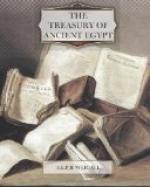The Egyptian peasants have a very strong belief in the power of such creatures of the spirit world. A native who was attempting recently to discover hidden treasure in a certain part of the desert, sacrificed a lamb each night above the spot where he believed the treasure to lie, in order to propitiate the djin who guarded it. On the other hand, however, they have no superstition as regards the sanctity of the ancient dead, and they do not hesitate on that ground to rifle the tombs. Thousands of graves have been desecrated by these seekers after treasure, and it is very largely the result of this that scientific excavation is often so fruitless nowadays. When an excavator states that he has discovered a tomb, one takes it for granted that he means a plundered tomb, unless he definitely says that it was intact, in which case one calls him a lucky fellow and regards him with green envy.
And thus we come back to my remarks at the beginning of this chapter, that there is a painful disillusionment awaiting the man who comes to dig in Egypt in the hope of finding the golden cities of the Pharaohs or the bejewelled bodies of their dead. Of the latter there are but a few left to be found. The discovery of one of them forms the subject of the next chapter.
CHAPTER VIII.
THE TOMB OF TIY AND AKHNATON.[1]
[Footnote 1: A few paragraphs
in this chapter also appear in my
‘Life and Times of Akhnaton,
Pharaoh of Egypt.’
(Wm. Blackwood & Sons, 1910.)]
In January 1907 the excavations in the Valley of the Tombs of the Kings at Thebes, which are being conducted each year by Mr Davis, brought to light the entrance of a tomb which, by its style, appeared to be that of a royal personage of the XVIIIth Dynasty. The Valley lies behind the cliffs which form the western boundary of Thebes, and is approached by a long winding road running between the rocks and rugged hills of the Lybian desert. Here the Pharaohs of the XVIIIth to the XXth Dynasties were buried in large sepulchres cut into the sides of the hills; and the present excavations have for their object the removal of the debris which has collected at the foot of these hills, in order that the tombs hidden beneath may be revealed. About sixty tombs are now open, some of which were already known to Greek and Roman travellers; and there are probably not more than two or three still to be discovered.
When this new tomb-entrance was uncovered I was at once notified, and proceeded with all despatch to the Valley. It was not long before we were able to enter the tomb. A rough stairway led down into the hillside, bringing us to the mouth of a passage which was entirely blocked by a wall of built stones. On removing this wall we found ourselves in a small passage, descending at a sharp incline to a chamber which could be seen a few yards farther on. Instead of this passage being free from debris, however,




